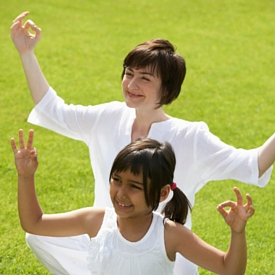
It’s National Physical Fitness and Sports Month! Staying fit can be a family affair and yoga with your kids is a great start to encouraging family fitness.
Vasanthi Bhat, author of three books and producer of 18 yoga DVDs, has been teaching yoga for more than 30 years.
“I started (teaching) family yoga five years ago to help family members develop and increase closeness, understanding, patience, and tolerance in this stressed out, fast-paced hectic life,” says the San Jose, California teacher.
Her classes are structured to meet the needs of her students’ physical and emotional health conditions, she says. “I (teach) meditations a few moments every day to help family members develop respect, love and forgiveness to strengthen the relationships,” she says.
And the benefits have been plenty. Bhat says she sees improved concentration, flexibility, toning and conditioning, relief for allergies, asthma, wheezing, Juvenile arthritis, heart conditions, eye disorders and improved self esteem, among her students.
Jodi Komitor, co-author of The Complete Idiot’s Guide to Yoga with Kids (Macmillian, 2000) and a registered yoga teacher, in New York City, founded her Next Generation Yoga studio in 1998, the first children’s yoga studio in the world, she says. Her classes for families start with children as young as 18 months old.
“Because yoga has become so mainstream, more and more people are aware of its benefits. Even parents who do not do yoga on their own, yet want to exercise, will contact me to do a family yoga class- because they know the benefits and want them for themselves and their kids,” Komitor says.
Some of her goals as a family yoga teacher is to help her students develop strong, flexible, healthy growing bodies, improve concentration, balance and body awareness and cultivate a peaceful, relaxed state of body and mind as well as encourage peer and social interaction, among others.
“Parents who take yoga understand the benefits – they are experiencing them on a daily basis, and would like their kids to experience them as well. Through yoga they have gained increased awareness in the world around them. They see the stress of media, noise, peer pressure, etc., on their kids and want to help relieve some of it,” says Deb Donofrio, a certified facilitator for YogaKids International in Baltimore. “Physically, children learn body awareness kinesthetically through movement in yoga. Children learn balance, coordination, focus, strength and cooperation. They realize that everyone has weaknesses and strengths and that yoga can help them in areas where they need improvement. Adult yoga classes are quiet and focused. Children’s yoga classes are full of laughter and discussion. Bringing the ages together to do yoga enhances everyone’s learning and understanding.”
Leah Panlilio, of New York City, practices yoga with her husband, Dennis and their son, Aidan.
“It’s not so much how we feel when we do yoga, as how we feel when we don’t,” says Panlilio about realizing the benefits. “One of the difficulties of family life in the hustle and bustle of the big city is that time is at a premium, or more to the point, there just isn’t enough of it. Sometimes sacrifices must be made, and our family yoga practice has certainly found itself on that alter more than once. However, the benefits of yoga and meditation color every aspect of our lives, so if our practice continually takes a back-seat to other ‘more pressing’ things, everything starts to feel off – everything suffers. It’s like a medicine you never actually see working – you just know you feel better when you take it.”
— Always make sure to take yoga from a trained professional, and take classes first, before relying on DVDs at home.
— Make sure your instructor is aware of any health conditions, since some poses (asanas) should not be practiced with some conditions.
— Make sure kids are aware of what feels good and what doesn’t when doing poses. Remind them not to be competitive and push the body because a sibling or parent can do the pose.
— Children who have physical handicaps should be approached a little differently. Make sure to discuss these with your instructor.
— Instructors warn against any forms of power yoga or aerobic yoga for children, and family yoga classes should stick to using gentle yoga techniques.
Yoga techniques to help kids sleep
Patti Teel, author of The Floppy Sleep Game Book and creator of The Floppy Sleep Game CD, uses various yoga techniques to help children relax to improve sleep.
She incorporates the yoga relaxation posture of shavasana – which means “corpse pose” – in reference to the deep state of relaxation that it elicits, into the before-bedtime routine.
“Shavasana is done while lying on your back in a supine position with arms at your sides, palms facing upward, and legs slightly parted. While it is often done at the end of a yoga class or anytime you want to relax deeply, I’ve found that it is an ideal way for children to relax in preparation for sleep,” she says. “I have children get in their beds and in child-like terms direct them to relax their bodies—starting with their toes, and working their way up to the tops of their heads.”
Teel directs children to focus on their breath. “(It) is a wonderful way to release mental and physical stress and tension. It calms the mind and induces a state of relaxation in children’s bodies.”
Here is a shavasana technique Teel recommends that can be done in bed:
Directions:
Hold each leg and arm stiffly and tightly for five or more seconds before letting it loosely ‘flop’ down on the bed. (Practice beforehand with a floppy stuffed animal.)
Tense and relax the face. For example, direct your child to keep his eyes closed and lift his eyebrows before lowering them and relaxing. Then have him close his eyes tightly shut, then relax his eyes, wrinkle his nose, and relax his nose, open his mouth widely, and then close his mouth and relax. (Tip: Remember to have your child hold the tension for five or more seconds before relaxing and pause between each of the directions.)
Step Two: Focus on the breath
Have children quietly listen to their own breath or practice diaphragmatic (belly) breathing.
Feel the Air as you Breathe
Directions:
Feel the air as you breathe in and out through your nose.
Breathe in, feel the cool air.
Breathe out, feel how it’s warmer.
Breathe in, feel the cool air.
Breathe out the warm air.
Breathe in, two three four.
Breathe out, two three four.
Breathe in, two three four.
Breathe out, two three four.
Once again, feel the air as you breathe in and out through your nose.
Continue by having children quietly attend to their own breath.
Belly Breathing (Diaphragmatic Breathing)
Directions:
Lay on your back
Put one hand on your belly.
Take a deep breath in.
Does your belly rise?
Take slow deep breaths and let your belly rise and fall.
Variation (Balloon Breathing)
Directions:
Have your child place a hand on his belly and imagine that there is a balloon inside.
Breathing in, two, three, four—your balloon fills up. Breathing out, two, three four—letting out the air.
Continue to slowly fill up your balloon and then slowly let out the air.
Step Three: Visualization
Directions:
At first, provide the structure for your child—taking him on an imaginary journey. I think of it as interactive storytelling; your child experiences the story as if he or she is truly living it. Visualization skills improve through practice, and before you know it your child will be effortlessly visualizing scenarios of his own choosing as he drifts off to sleep.


